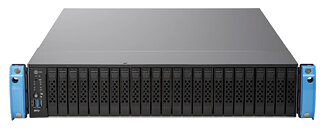
QNAP Releases Dual-Active Controller ES1686dc R2 NAS
QNAP Systems, Inc. today launched the ES1686dc R2, a high-performance 16-bay SAS 12 Gb/s enterprise NAS engineered for mission-critical applications. Featuring dual active-active controllers, it ensures High Availability (HA) and delivers uncompromising performance for demanding workloads. Designed for enterprise file and virtualization storage, the ES1686dc R2 minimizes downtime with redundant controllers and power supplies, enabling seamless component replacement. This ensures continuous operations, reliability, and stability for business-critical environments.
"The ES1686dc R2 delivers outstanding performance and a reliable high-availability storage solution," said Waterball Liu, Product Manager of QNAP, adding: "The QES operating system features an intuitive user-friendly interface with enhanced functionality, enabling customers to effortlessly adopt professional-grade dual-controller enterprise storage when high availability is required. Whether deployed as a mission-critical file server, virtualization server, VDI, or for efficient file backup and recovery, the ES1686dc R2 meets service-level agreements for both performance and uptime."
"The ES1686dc R2 delivers outstanding performance and a reliable high-availability storage solution," said Waterball Liu, Product Manager of QNAP, adding: "The QES operating system features an intuitive user-friendly interface with enhanced functionality, enabling customers to effortlessly adopt professional-grade dual-controller enterprise storage when high availability is required. Whether deployed as a mission-critical file server, virtualization server, VDI, or for efficient file backup and recovery, the ES1686dc R2 meets service-level agreements for both performance and uptime."































































